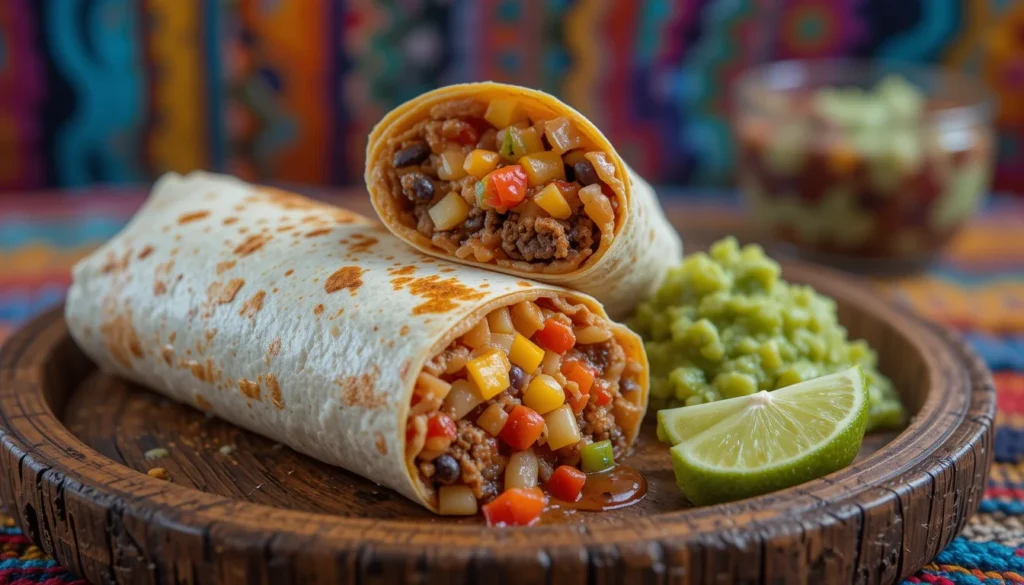When it comes to burritos, there’s a lot more to this humble dish than meets the eye—or your taste buds! A burrito isn’t just a tortilla filled with random ingredients; it’s a flavorful journey that captures Mexico’s vibrant culture. So, what do Mexicans put in their burritos? Let’s explore the origins, traditional elements, and surprising twists of this cherished dish.
Table of Contents
The Origin and Evolution of Burritos
Burritos have become a global sensation, but their roots lie deep in Mexican cuisine. The term “burrito,” which means “little donkey” in Spanish, might sound peculiar. But the name likely stems from the practicality of this food—much like donkeys are great for carrying loads, burritos pack an entire meal into a neat, portable package.
The burrito’s story begins in Northern Mexico, where flour tortillas were more common than their corn counterparts. Northern Mexican ranchers and workers needed a quick, filling meal, and the burrito was born. These early burritos were simple, containing just a protein, like beef or beans, and maybe a sprinkle of cheese.
As Mexican cuisine crossed borders into the U.S., burritos grew in size and complexity. They became filled with everything from rice to guacamole, evolving into the hearty creations we see today.
Traditional Mexican Burrito Ingredients
Now let’s get into the meat of the matter—literally! Traditional Mexican burritos are all about balance and simplicity, highlighting the fresh, bold flavors of authentic Mexican ingredients.
Essential Proteins Found in Mexican Burritos
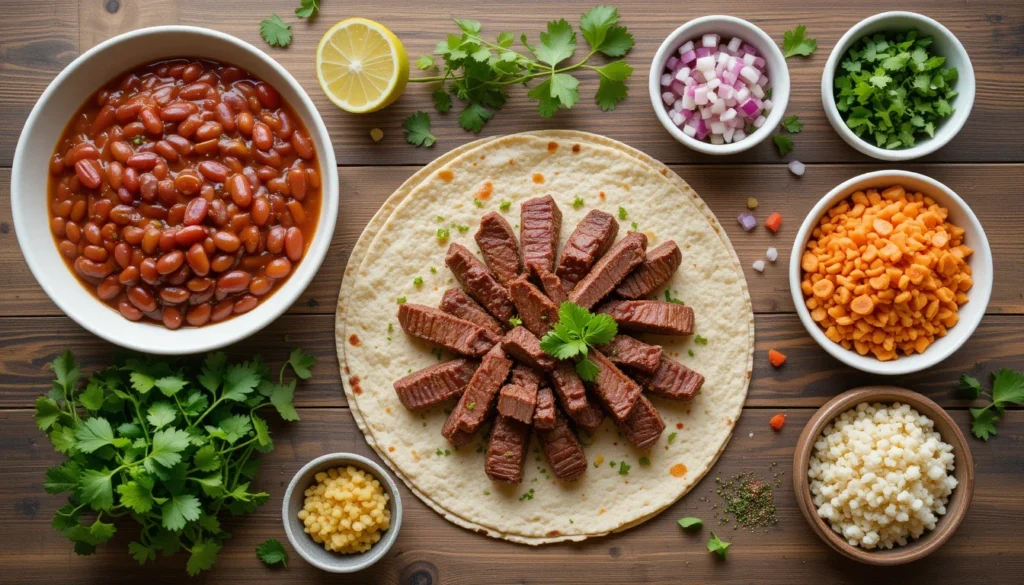
In Mexico, the protein is the heart of the burrito. Popular choices include carne asada (grilled beef), barbacoa (slow-cooked beef), and pollo (chicken). Some regions opt for beans as the main filling, often cooked and seasoned to perfection.
Seafood, such as shrimp or fish, also makes an appearance in coastal regions, providing a lighter, refreshing twist to the dish.
Fresh Vegetables That Add Flavor and Crunch
Vegetables play a crucial role in traditional burritos. Think fresh tomatoes, crunchy lettuce, and crisp onions. Bell peppers or poblano peppers might also make their way inside, adding a pop of color and flavor.
Some burritos include sautéed veggies, like zucchini or mushrooms, for an earthy, hearty touch. These components not only enhance the taste but also bring a satisfying texture to every bite.
Authentic Spices and Seasonings
Mexican burritos are bursting with flavor thanks to a careful blend of spices. Common seasonings include cumin, chili powder, and oregano, creating a warm, aromatic base. A dash of lime juice or fresh cilantro can elevate the flavor profile, making each bite zesty and fresh.
Types of Tortillas Used in Mexican Burritos
The tortilla is the unsung hero of a great burrito. In Mexico, traditional burritos are typically wrapped in a soft flour tortilla. Flour tortillas are more pliable than corn ones, making them perfect for holding hearty fillings without falling apart.
The tortilla itself can vary in size and thickness, depending on the region or cook’s preference. While you might find corn tortillas used for tacos, flour tortillas reign supreme in the burrito world.
Regional Variations in Mexican Burritos
Mexico’s diverse geography and cultural influences mean that burritos vary greatly depending on where you go. Each region has its unique spin on this classic dish.
Northern Mexico’s Classic Burritos
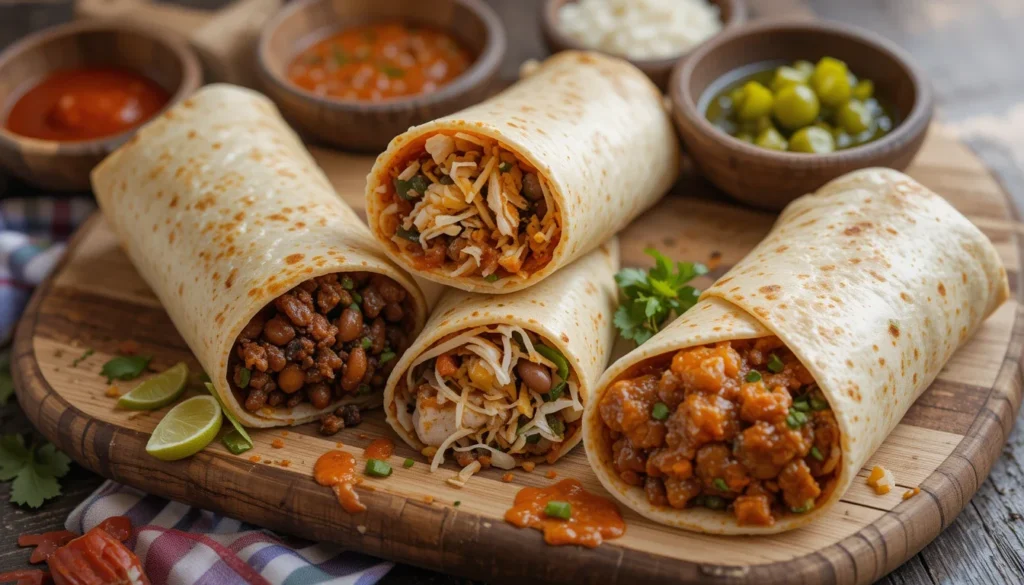
Northern Mexico, especially the state of Chihuahua, is the birthplace of the burrito. Here, simplicity is key. Classic burritos often contain just one or two ingredients, such as stewed meat and beans, wrapped snugly in a flour tortilla.
This minimalist approach ensures that the natural flavors of each ingredient shine through without being overpowered.
Coastal Variations and Seafood Burritos
Head to Mexico’s coastal regions, and you’ll find burritos filled with fresh seafood. Shrimp, fish, and even octopus are common fillings, often paired with tangy sauces and crunchy slaw. These burritos are a reflection of the abundant ocean bounty and vibrant coastal lifestyle.
Urban Twists: How Cities Influence Burrito Recipes
In Mexico City and other urban hubs, burritos take on a more experimental vibe. You might find burritos stuffed with everything from exotic cheeses to fusion-inspired ingredients like mole sauce. These versions cater to modern palates while keeping the traditional essence alive.
Common Problems with Homemade Burritos and Their Solutions
Making burritos at home can be a delightful experience, but it’s not without its challenges. From soggy tortillas to uneven fillings, figuring out what do Mexicans put in their burritos can sometimes feel overwhelming. Don’t worry—there’s a fix for every problem!
Burritos Falling Apart: How to Wrap Like a Pro
A poorly wrapped burrito is a recipe for disaster. To avoid this, use a warm, pliable tortilla—it’s much easier to work with. Start by placing the filling slightly off-center. Fold in the sides, roll tightly from the bottom, and voila! You have a burrito that stays intact.
Avoid overfilling the tortilla, as that’s one of the main reasons burritos burst open. If you’re new to this, practice makes perfect. Wrapping a burrito can feel like folding origami with food, but it’s worth the effort!
Achieving the Perfect Ingredient Balance
One common mistake with burritos is throwing in too many ingredients. While it might be tempting to pile on everything in your fridge, balance is key. Each bite should deliver a harmonious blend of flavors, not an overwhelming jumble.
Stick to a protein, a couple of vegetables, and one or two sauces. This not only ensures better taste but also prevents your burrito from becoming too heavy or soggy.
Choosing Fresh and Authentic Ingredients
The quality of your ingredients can make or break your burrito. Opt for fresh vegetables, high-quality meats, and authentic Mexican spices whenever possible. If you’re outside Mexico, visit a specialty market for ingredients like cotija cheese, chipotle peppers, or homemade tortillas.
Freshness doesn’t just enhance the flavor—it transforms the entire burrito experience. There’s something magical about biting into a burrito filled with crisp vegetables and juicy, well-seasoned meat.
Modern Adaptations of Mexican Burritos
While the traditional burrito remains a favorite, what do Mexicans put in their burritos when modern adaptations come into play? The modern world has introduced innovative twists. These adaptations cater to dietary preferences and global tastes, proving that the burrito is a dish for everyone.
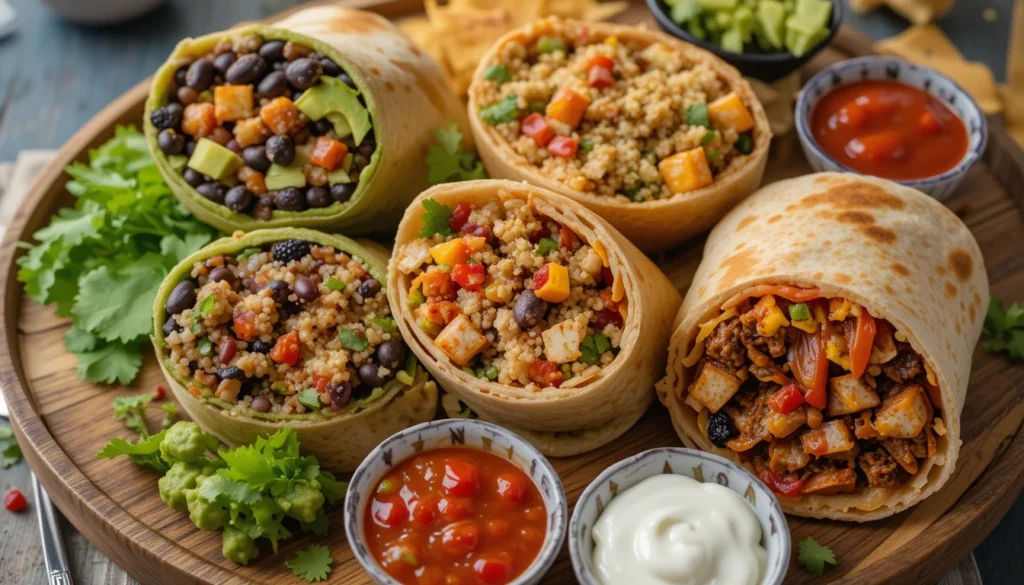
Vegetarian and Vegan Burrito Options
Vegetarians and vegans rejoice—burritos are incredibly versatile. Replace meat with black beans, lentils, or tofu for a plant-based protein boost. Add grilled veggies like zucchini, bell peppers, or mushrooms to give the burrito a hearty texture.
Vegan burritos often include plant-based cheeses and creamy avocado to replicate traditional flavors. Salsa, cilantro, and a drizzle of lime juice tie everything together for a refreshing and satisfying meal.
Fusion Burritos: Combining Global Flavors
Fusion burritos are where creativity takes center stage. Imagine an Indian-inspired burrito filled with chicken tikka, basmati rice, and mint chutney, or a Korean-style burrito with bulgogi beef and kimchi. These versions blend the traditional burrito framework with the unique flavors of different cuisines.
These cross-cultural creations showcase how food evolves as it travels, making the burrito a universal dish that breaks boundaries.
Health-Conscious Variations of the Burrito
For those watching their waistlines, there are healthier takes on the burrito. Swap the flour tortilla for a whole-wheat or gluten-free version. Use brown rice or quinoa instead of white rice, and opt for lean proteins like grilled chicken or shrimp.
Light sauces, such as Greek yogurt-based crema, can replace heavier ones, keeping the burrito flavorful without the extra calories. These adaptations prove that you can enjoy burritos guilt-free without sacrificing taste.
Tips for Making Authentic Mexican Burritos at Home
Recreating the magic of a Mexican burrito at home might sound daunting, but it’s easier than you think. With the right approach and ingredients, you can bring the authentic flavors of Mexico to your kitchen and discover firsthand what do Mexicans put in their burritos to make them so irresistible.
Discover how cheese elevates recipes in The Ultimate Guide to Grilled Cheese Burrito.
Finding Authentic Mexican Ingredients Outside Mexico
Finding authentic ingredients is often the first hurdle. Look for a local Latin market where you can source tortillas, dried chilies, Mexican cheese, and spices. If you can’t find everything locally, online specialty stores are a fantastic resource.
Freshness is paramount. For instance, making your own salsa or guacamole instead of using store-bought versions can elevate your burrito from good to great.
Perfecting the Cooking Process for Proteins
Cooking your protein correctly is crucial for achieving that authentic flavor. Marinate your meats with lime juice, garlic, and spices like cumin and paprika. Slow-cooked options like carnitas or barbacoa bring out deep, rich flavors that are quintessentially Mexican.
Grilling is another excellent option, especially for carne asada. A quick sear locks in the juices, giving you tender, flavorful meat that pairs beautifully with other fillings.
The Art of Layering Ingredients for Optimal Taste
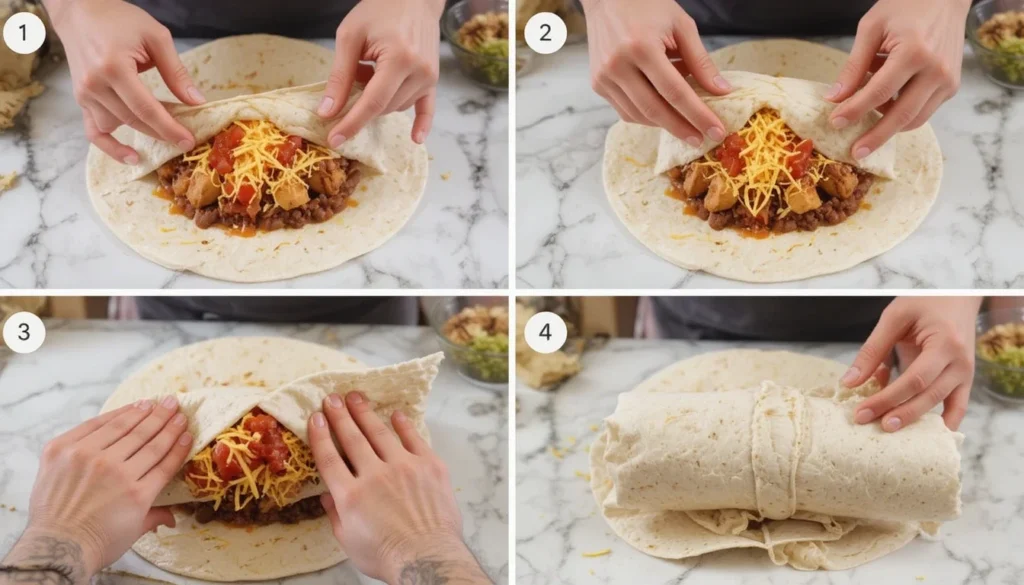
The order of ingredients in a burrito isn’t just about aesthetics—it affects the overall flavor and texture. Start with a spread of refried beans or rice to create a sturdy base. Add the protein, followed by vegetables, and finish with sauces or cheese.
Layering ensures that each bite contains a bit of everything, delivering a well-rounded and satisfying flavor.
The Cultural Significance of Burritos in Mexican Cuisine
Burritos are much more than a meal they’re a symbol of Mexican culinary ingenuity and cultural pride. While they may seem simple, their history and versatility make them a beloved part of Mexico’s gastronomic identity.
Burritos as Street Food: A Staple in Mexican Markets
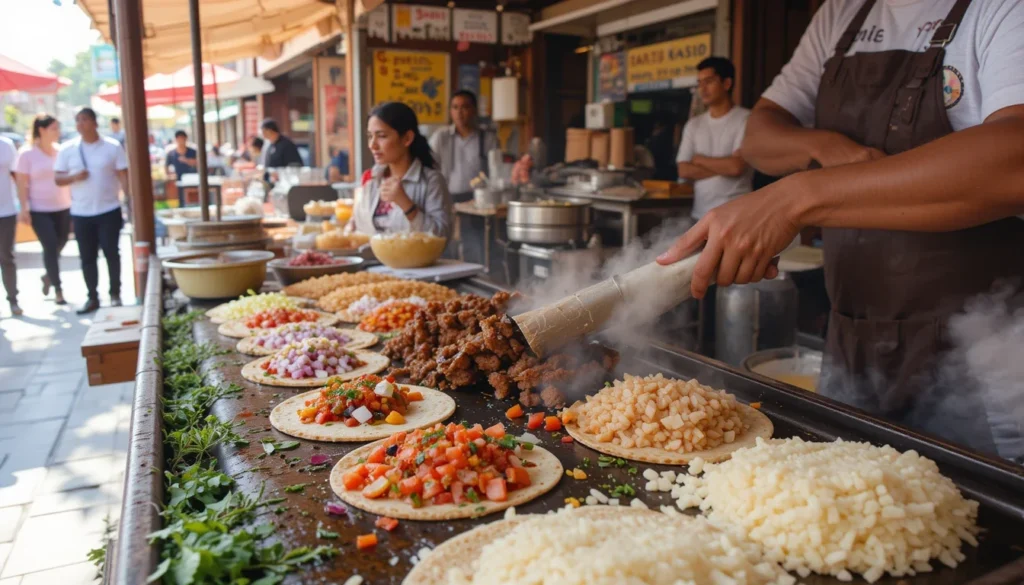
Walk through a bustling Mexican market, and you’ll likely encounter a vendor skillfully assembling burritos. What do Mexicans put in their burritos? Street food is a cornerstone of Mexican culture, and burritos play a starring role.
Their portability makes them perfect for busy market-goers. Vendors often prepare burritos with just a few high-quality ingredients, like beans, cheese, and meat, wrapped tightly for on-the-go consumption. These burritos reflect the fast-paced, communal nature of Mexican markets while staying true to traditional flavors.
Burritos in Festive and Everyday Settings
In Mexico, burritos are versatile enough to appear in both everyday meals and celebratory feasts. For a quick lunch, a simple burrito filled with beans and cheese does the trick. During gatherings, families might prepare larger burritos with an array of fillings, sharing them as a communal dish.
Burritos also embody hospitality. Offering a burrito to a guest is a gesture of care, reflecting the warmth and generosity that defines Mexican culture.
How Burritos Represent Mexico’s Culinary Diversity
Mexico is a tapestry of regional cuisines, and what do Mexicans put in their burritos is a reflection of this diversity. From the hearty, meat-filled burritos of Chihuahua to the seafood-laden variations on the coast, each version tells a story of local traditions and resources.
The burrito’s ability to adapt while retaining its essence mirrors the resilience and creativity of Mexican cuisine. It’s a dish that evolves but never loses its roots.
FAQs
What’s the most common filling for a traditional Mexican burrito?
The most common fillings are refried beans, a protein like carne asada or barbacoa, and sometimes cheese. Simplicity is key in traditional Mexican burritos.
Are burritos popular across all of Mexico?
Not exactly! Burritos are more common in Northern Mexico, where flour tortillas are a staple. In other regions, tacos and other dishes might take center stage.
What’s the difference between American and Mexican burritos?
American burritos tend to be larger and filled with extras like rice, guacamole, and sour cream. Mexican burritos are smaller and focus on fewer, high-quality ingredients.
Can I make authentic burritos without access to Mexican markets?
Yes! While authentic ingredients enhance the flavor, you can substitute with locally available options and still achieve a delicious result.
What’s the secret to a perfectly wrapped burrito?
The secret lies in using a warm tortilla, avoiding overfilling, and folding tightly. Practice makes perfect!
Do Mexicans use rice in their burritos?
Rice is more common in Americanized burritos. Traditional Mexican burritos rarely include rice, focusing instead on beans, meat, and vegetables.
Conclusion: The Endless Creativity of Mexican Burritos
So, what do Mexicans put in their burritos? The answer is as varied as the regions, traditions, and personal preferences that define this iconic dish. From the simplicity of beans and cheese to the complexity of fusion-inspired fillings, burritos celebrate the art of blending flavors and textures into one cohesive bite.
Whether enjoyed as street food, part of a family meal, or in a modern adaptation, burritos continue to capture the hearts and palates of food lovers worldwide. They are a testament to the richness of Mexican culture, proving that even the simplest ingredients can create something extraordinary.
So next time you take a bite of a burrito, remember—you’re not just eating a meal; you’re experiencing a small piece of Mexico’s culinary soul.
For more insights into what makes burritos special, check out What Do Authentic Burritos Have?, and if you want to deep dive in the world of Burritos check out the Most Common Ingredients in a Burrito.
Print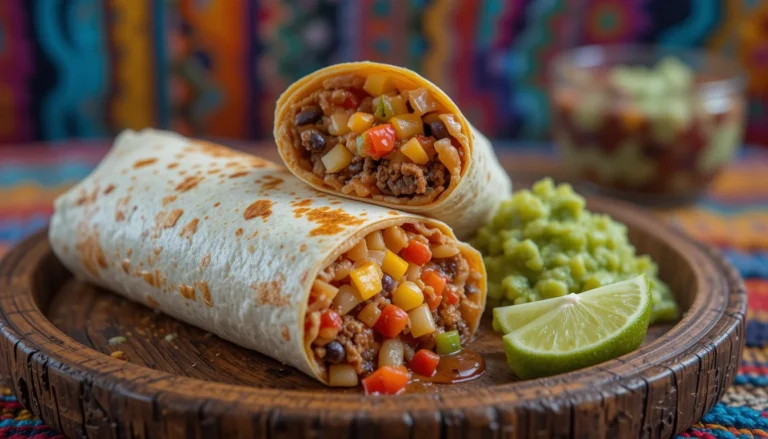
Authentic Mexican Burrito
A classic Mexican burrito loaded with flavorful seasoned rice, beans, fresh veggies, and a deliciously spiced filling, all wrapped in a warm tortilla!
- Total Time: 25 minutes
- Yield: 4 burritos 1x
Ingredients
For the Burrito Filling:
- 2 cups cooked rice
- 1 cup black beans, drained and rinsed
- 1 cup cooked and seasoned chicken or beef alternative (tofu, jackfruit, or mushrooms for a vegan option)
- 1 small onion, diced
- 1 bell pepper, diced
- 2 cloves garlic, minced
- 1 tsp cumin
- 1 tsp smoked paprika
- ½ tsp chili powder
- ½ tsp salt
- ½ tsp black pepper
- 1 tbsp olive oil
For the Burrito Assembly:
- 4 large flour tortillas
- ½ cup guacamole
- ½ cup salsa
- ½ cup shredded lettuce
- ½ cup diced tomatoes
- ½ cup shredded cheese (or vegan cheese alternative)
Instructions
Prepare the Filling: Heat olive oil in a pan over medium heat. Add onions and bell peppers, sautéing until soft.
Stir in garlic, cumin, paprika, chili powder, salt, and black pepper. Cook for another minute.
Add the cooked protein choice (chicken, tofu, or jackfruit) and mix well. Cook for 3-5 minutes.
Stir in black beans and cooked rice, mixing until everything is well combined. Remove from heat.
Assemble the Burrito:
- Warm tortillas in a dry skillet or microwave for a few seconds to make them pliable.
- Spread guacamole in the center of each tortilla.
- Add a generous scoop of the burrito filling, followed by salsa, lettuce, tomatoes, and cheese.
- Fold in the sides, then roll tightly into a burrito.
Serve & Enjoy: Slice in half and serve with extra salsa or your favorite hot sauce!
- Prep Time: 15 Min
- Cook Time: 10 Min
Nutrition
- Serving Size: 1
- Calories: 450

